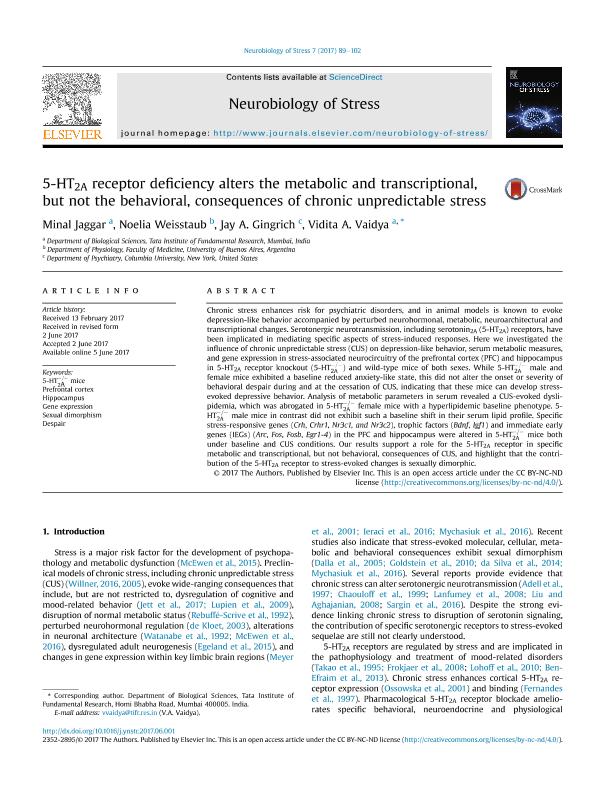Mostrar el registro sencillo del ítem
dc.contributor.author
Jaggar, Minal
dc.contributor.author
Weisstaub, Noelia V.

dc.contributor.author
Gingrich, Jay A.
dc.contributor.author
Vaidya, Vidita A.
dc.date.available
2018-06-15T17:48:03Z
dc.date.issued
2017-12
dc.identifier.citation
Jaggar, Minal; Weisstaub, Noelia V.; Gingrich, Jay A.; Vaidya, Vidita A.; 5-HT2A receptor deficiency alters the metabolic and transcriptional, but not the behavioral, consequences of chronic unpredictable stress; Elsevier Inc; Neurobiology of Stress; 7; 12-2017; 89-102
dc.identifier.issn
2352-2895
dc.identifier.uri
http://hdl.handle.net/11336/48821
dc.description.abstract
Chronic stress enhances risk for psychiatric disorders, and in animal models is known to evoke depression-like behavior accompanied by perturbed neurohormonal, metabolic, neuroarchitectural and transcriptional changes. Serotonergic neurotransmission, including serotonin2A (5-HT2A) receptors, have been implicated in mediating specific aspects of stress-induced responses. Here we investigated the influence of chronic unpredictable stress (CUS) on depression-like behavior, serum metabolic measures, and gene expression in stress-associated neurocircuitry of the prefrontal cortex (PFC) and hippocampus in 5-HT2A receptor knockout (5-HT2A−/−) and wild-type mice of both sexes. While 5-HT2A−/− male and female mice exhibited a baseline reduced anxiety-like state, this did not alter the onset or severity of behavioral despair during and at the cessation of CUS, indicating that these mice can develop stress-evoked depressive behavior. Analysis of metabolic parameters in serum revealed a CUS-evoked dyslipidemia, which was abrogated in 5-HT2A−/− female mice with a hyperlipidemic baseline phenotype. 5-HT2A−/− male mice in contrast did not exhibit such a baseline shift in their serum lipid profile. Specific stress-responsive genes (Crh, Crhr1, Nr3c1, and Nr3c2), trophic factors (Bdnf, Igf1) and immediate early genes (IEGs) (Arc, Fos, Fosb, Egr1-4) in the PFC and hippocampus were altered in 5-HT2A−/− mice both under baseline and CUS conditions. Our results support a role for the 5-HT2A receptor in specific metabolic and transcriptional, but not behavioral, consequences of CUS, and highlight that the contribution of the 5-HT2A receptor to stress-evoked changes is sexually dimorphic.
dc.format
application/pdf
dc.language.iso
eng
dc.publisher
Elsevier Inc
dc.rights
info:eu-repo/semantics/openAccess
dc.rights.uri
https://creativecommons.org/licenses/by-nc-nd/2.5/ar/
dc.subject
5-Ht2a&Minus;/&Minus; Mice
dc.subject
Despair
dc.subject
Gene Expression
dc.subject
Hippocampus
dc.subject
Prefrontal Cortex
dc.subject
Sexual Dimorphism
dc.subject.classification
Inmunología

dc.subject.classification
Medicina Básica

dc.subject.classification
CIENCIAS MÉDICAS Y DE LA SALUD

dc.title
5-HT2A receptor deficiency alters the metabolic and transcriptional, but not the behavioral, consequences of chronic unpredictable stress
dc.type
info:eu-repo/semantics/article
dc.type
info:ar-repo/semantics/artículo
dc.type
info:eu-repo/semantics/publishedVersion
dc.date.updated
2018-06-13T15:08:57Z
dc.journal.volume
7
dc.journal.pagination
89-102
dc.journal.pais
Países Bajos

dc.journal.ciudad
Amsterdam
dc.description.fil
Fil: Jaggar, Minal. Tata Institute of Fundamental Research; India
dc.description.fil
Fil: Weisstaub, Noelia V.. Consejo Nacional de Investigaciones Científicas y Técnicas. Oficina de Coordinación Administrativa Houssay. Instituto de Fisiología y Biofísica Bernardo Houssay. Universidad de Buenos Aires. Facultad de Medicina. Instituto de Fisiología y Biofísica Bernardo Houssay; Argentina
dc.description.fil
Fil: Gingrich, Jay A.. Columbia University; Estados Unidos
dc.description.fil
Fil: Vaidya, Vidita A.. Tata Institute of Fundamental Research; India
dc.journal.title
Neurobiology of Stress
dc.relation.alternativeid
info:eu-repo/semantics/altIdentifier/doi/http://dx.doi.org/10.1016/j.ynstr.2017.06.001
dc.relation.alternativeid
info:eu-repo/semantics/altIdentifier/url/https://www.sciencedirect.com/science/article/pii/S2352289517300073
Archivos asociados
